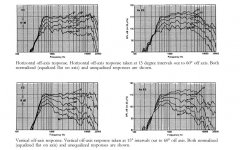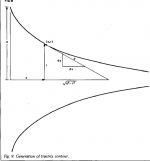If a beamy response where a horn stops working is what one considers "controlled"
I find it a bit silly to consider any 2way 2" exit system to have "good" polars
I'm quite happy with my JBL 2385a's crossed to 15" drivers (800Hz xo)
Attachments
Hi guys!
Any ideas on the smallest footprint Horn and Driver combo that can go down to 500hz?
Why not this one ?
TRACTRIX-350 - Horns by Auto-Tech
Only 235mm
This design has be discovered by Claude Perrault in 1670... not really revolutionary today
The K-510 is 15" x 9" x 5" (381 x 229 x 127 mm).
The horn profile to which you linked is nothing like a modified tractrix profile. There is a world of difference in polars...and especially in its overall depth. The K-510 is about half the depth of a tractrix profile horn you posted.
Perhaps you should look at the K-510 profile more closely. I think you'll find it's much different--mouth, throat, and everything in between. Here's a clue from Bruce Edgar's tractrix horn paper from 37 years ago...
Of course, if controlled directivity doesn't really matter to you (as is the case with a straight Le Cléac'h, exponential, hyperbolic, or even conical area expansion horn, regardless of its chosen throat geometry), then virtually anything can be substituted...even the cheapest sort of Asian knockoff from a horn profile originally marketed ~40 years ago.
Chris
Attachments
Last edited:
The K-510 is 15" x 9" x 5" (381 x 229 x 127 mm)
The horn profile to which you linked is nothing like a modified tractrix profile. There is a world of difference in polars...and especially in its overall depth. The K-510 is about half the depth of a tractrix profile horn you posted.
Perhaps you should look at the K-510 profile more closely. I think you'll find it's much different--mouth, throat, and everything in between. Here's a clue from Bruce Edgar's tractrix horn paper from 37 years ago...
Of course, if controlled directivity doesn't really matter to you (as is the case with a straight Le Cléac'h, exponential, hyperbolic, or even conical area expansion horn, regardless of its chosen throat geometry), then virtually anything can be substituted...even the cheapest sort of Asian knockoff from a horn profile originally marketed ~40 years ago.
Chris
You are right, my room is so small that i don't care much about polars, i've forgotten this when i've posted.
I'm sorry, so here for your eyes, a 350Hz and 235mm paper tractrix made yesterday evening and unmolded this morning.
The "Joyeux anniversaire" balloon is peeled now
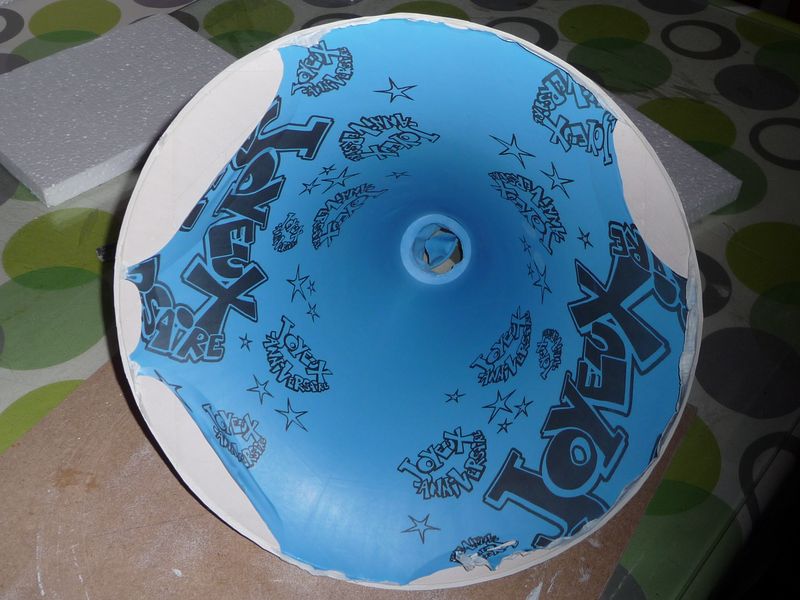
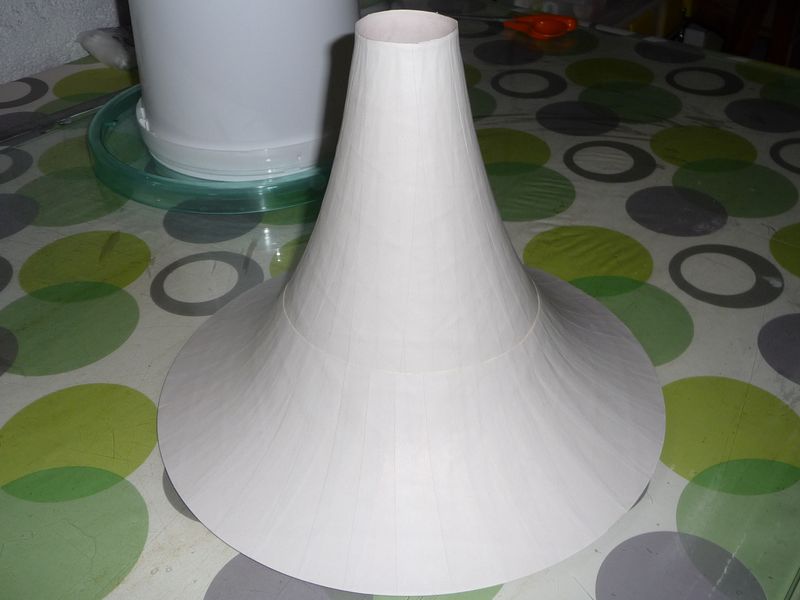
You are right, my room is so small that i don't care much about polars...
How did you arrive at this conclusion that polars don't matter in small rooms? (If this is just humor, I clearly missed it.)
I conversed with JMMLC on this subject in late 2010 before his untimely passing. Here is his reply (of which I clearly but respectfully disagree with his conclusions):
RE: 16 horns measurements - Jmmlc - High Efficiency Speaker Asylum
Regards,
Chris
How did you arrive at this conclusion that polars don't matter in small rooms? (If this is just humor, I clearly missed it.)
I conversed with JMMLC on this subject in late 2010 before his untimely passing. Here is his reply (of which I clearly but respectfully disagree with his conclusions):
RE: 16 horns measurements - Jmmlc - High Efficiency Speaker Asylum
Regards,
Chris
It is a mix of humor and conjuncturism because the technological choice of a profile over another is depending on too much factors to be critisized without a wide panel of informations concerning the application IMHO.
I don't understand the choice of a 2" compression with a WG at all
If someone can ...

Klipsch professional certainly understands it (I assume that you've heard of them)...I don't understand the choice of a 2" compression with a WG at all
http://assets.klipsch.com/product-specsheets/KPT-942-Data-Sheet-v04.pdf
http://assets.klipsch.com/product-specsheets/KPT-904-Data-Sheet-v04.pdf
http://assets.klipsch.com/product-specsheets/KPT-942-4-B-Data-Sheet-v05.pdf
http://assets.klipsch.com/product-specsheets/KPT-325-Data-Sheet-v04.pdf
...and the one that I've owned for the past ten years, the KPT-Jubilee (the two-way version of this):
http://assets.klipsch.com/product-specsheets/KPT-JUBILEE535-B-Data-Sheet-v05.pdf
...among other loudspeaker configurations. There are more than 40 people that currently own these in home hi-fi setups. I've helped about a dozen of those dial-in their setups using DSP crossovers.
I don't understand why so many people out-of-hand (almost mindlessly) insert another midrange horn/driver and an extra set of electrical crossover filters in three-way configuration when they can avoid all that and have controlled directivity without significant crossover-induced polar coverage mismatches in the 1-8 kHz region.
But, of course, I might have overlooked the fact that many don't believe in controlled coverage, as you stated above...
Chris
Chris
Yes, but how do you control the direcivity at 500Hz with a WG ?
Wow, I find that a lot of folks are not doing very much reading in this thread.
Read page two of this thread for the measured anechoic directivity of the very small K-510 horn in the vertical axis. The horizontal axis is better (although I'm not at liberty to post that particular plot).
Here is an anechoically derived directivity plot of the K-402 horn that I use on top of my Jubilees:

If you don't like polar plots, then here is a cartesian plot of the -6 dB point:

And a horizontal spectrogram of the K-402 used in a MEH design, as measured by myself in my own backyard (the dropouts in performance at 130 and 470 Hz were issues with on-axis EQing of the prototype that have since been corrected). Note the measured directivity using a very inexpensive 2" compression driver above 8 kHz, like on the K-510 directivity plot):
Read page two of this thread for the measured anechoic directivity of the very small K-510 horn in the vertical axis. The horizontal axis is better (although I'm not at liberty to post that particular plot).
Here is an anechoically derived directivity plot of the K-402 horn that I use on top of my Jubilees:

If you don't like polar plots, then here is a cartesian plot of the -6 dB point:

And a horizontal spectrogram of the K-402 used in a MEH design, as measured by myself in my own backyard (the dropouts in performance at 130 and 470 Hz were issues with on-axis EQing of the prototype that have since been corrected). Note the measured directivity using a very inexpensive 2" compression driver above 8 kHz, like on the K-510 directivity plot):
An externally hosted image should be here but it was not working when we last tested it.
Read page two of this thread for the measured anechoic directivity of the very small K-510 horn in the vertical axis. The horizontal axis is better (although I'm not at liberty to post that particular plot)
Could you show the Gain and the THD of the K-510 please ?
The smallest footprint available with a 2" and a real horn that loads the compression efficiently down to 500hz is a tractrix 350 IMO.
I believe it's your turn to show some data. How about a polar plot?
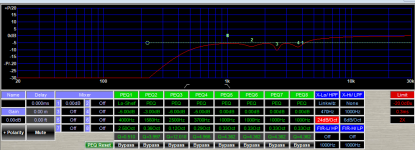
Note the drive level of the compression driver/horn (110 dB at one metre on-axis)...
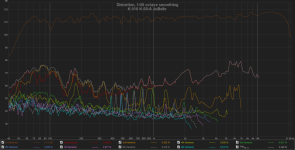
I'm not sure who uses harmonic distortion since it's one of the least useful measures that I've seen when measuring horns/compression drivers. (Dual-tone modulation distortion is a much better measure in my experience.)
Chris

Note the drive level of the compression driver/horn (110 dB at one metre on-axis)...

I'm not sure who uses harmonic distortion since it's one of the least useful measures that I've seen when measuring horns/compression drivers. (Dual-tone modulation distortion is a much better measure in my experience.)
Chris
Why the arguments ????
A simple synergy horn with DSP will blow away any conventional direct radiator set up down to around 300hz
Wether it be la cleach / klipsh / jbl/ altec/ tractix or otherwise
Horns have always been built around the driver of yesteryear inducing honk to extrapolate lower frequencies
Yesteryear drivers can be manipulated around horns of today (danley) using dsp
People tend to forget the majority of horns /waveguides are for PA use who gives a monkey about anything 30 degrees off axis it’s all about home listening and any sound bouncing off walls ceilings etc adds nuainces
A simple synergy horn with DSP will blow away any conventional direct radiator set up down to around 300hz
Wether it be la cleach / klipsh / jbl/ altec/ tractix or otherwise
Horns have always been built around the driver of yesteryear inducing honk to extrapolate lower frequencies
Yesteryear drivers can be manipulated around horns of today (danley) using dsp
People tend to forget the majority of horns /waveguides are for PA use who gives a monkey about anything 30 degrees off axis it’s all about home listening and any sound bouncing off walls ceilings etc adds nuainces
A simple synergy horn with DSP will blow away any conventional direct radiator set up down to around 300hz
In fact, MEHs sound even better full-range--down to 50 Hz or below, like the bigger Danley Synergies. Why stop at 500 Hz?
People tend to forget the majority of horns /waveguides are for PA use...
Note that the Klipsch designs that I posted links to above are not PA loudspeakers--but rather cinema loudspeakers. Their off-axis performance is a major determinant of whether or not they make it in their marketplace. Every seat in the house must sound good, and you can't do that with PA loudspeakers that have poor coverage vs. frequency. This is why the Klipsch pro line is doing so well with home hi-fi guys. I assume that this observation is also true for other cinema loudspeaker makers. There is a wide gulf of difference between simple PA and cinema in my experience. Another note: virtually all cinema loudspeakers have posted EASE data online. This is far beyond what any consumer hi-fi loudspeaker makers post (but it would be easy for them to do it).
Why Danley Sound Labs doesn't sell more loudspeakers to the cinema community is a bit of a mystery. Perhaps it's just the marketplace that tends to favor known brands.
I do know that some of the worst cinema loudspeakers that I've heard in the last decade had JBL emblems on them. They're harsh and "loud sounding".
Unfortunately danley knows his design is the the end game
Sound / wavelengths are restricted to the universe
Easy to replicate with DSP not so easy passive which makes copying hard.
Cinemas in your time and mine will at some stage be using meh/danley design
Don’t pass on jbl as they make incredible drivers.
I have built prototype horns that blew away jbl official horns and measured which several people recommended those horns. I thought what the hell they going on about they sound shite.
Using a 2445j driver on a 2380a horn is good
But using a 2445j driver in diy horn is unbelievable with dsp
Same as altec 500a horn it rings but only at certain frequencies and it does give drivers a very good gain xover is horn honk dependent
To many horns are asked to cover a wide frequency
Jbl buttcheeks are great don’t expect them to deliver 1000hz up they squeal
Sound / wavelengths are restricted to the universe
Easy to replicate with DSP not so easy passive which makes copying hard.
Cinemas in your time and mine will at some stage be using meh/danley design
Don’t pass on jbl as they make incredible drivers.
I have built prototype horns that blew away jbl official horns and measured which several people recommended those horns. I thought what the hell they going on about they sound shite.
Using a 2445j driver on a 2380a horn is good
But using a 2445j driver in diy horn is unbelievable with dsp
Same as altec 500a horn it rings but only at certain frequencies and it does give drivers a very good gain xover is horn honk dependent
To many horns are asked to cover a wide frequency
Jbl buttcheeks are great don’t expect them to deliver 1000hz up they squeal
Easy to replicate with DSP not so easy passive which makes copying hard.
Don't try to copy the passive crossover designs. Even Tom himself says that the good DSP crossovers perform better than the passives they provide. The passives sell in a marketplace that doesn't like bi-amping and tri-amping, i.e., the permanent-install PA marketplace (stadiums, etc.).
Cinemas in your time and mine will at some stage be using meh/danley design
I agree, but it will clearly take a lot more time. I think that there is probably a lot of ghosting by competitors going on in the cinema marketplace, plus each manufacturer in that market must sell a lot more than just loudspeakers--they also must sell their "dialed-in solutions" in the form of software and integrated electronics. Danley hasn't been doing that nearly as much as, say, Meyer, etc.
Don’t pass on jbl as they make incredible drivers.
Yes, but the price is really high, and they are typically not integrated nearly as well into their loudspeaker models, IMHE. In fact it's been a joke among the Klipsch community that JBL puts drivers into boxes, but Klipsch produces loudspeakers--not collections of its drivers.
I think that MEHs are the real long-term solution. Tom has the solution in hand, I think. I'd love to go to the cinema and hear Jericos up front and synergies surrounding, with their big TH subs providing an extended bass performance. That would be something to pay a little money to go see/hear.
Chris
I've tried some of these 2" CD. IMO, they are good, but not above 10kHz.
The B&C spec sheet for the DE750 shows what you'd expect from a big titanium diaphragm: they get pretty rough >10kHz.
...but I'd still like to see your plots for it. Could you post plots in the K-510 vs. that unbranded horn?
I used to have a pair of these (mine were the neo version, DE950s - half the weight & twice the price - but basically the same driver). I tried them on some PA horns (these if I remember correctly), and also on a horn that I built specifically for the driver. I tried changing the eq and positioning, but they always sounded a bit 'steely', presumably because of that harsh HF.
Since my existing system was better, I sold the B&C drivers and gave away the horn.
giving the horn away
That's exactly what I was using until recently*
Subjectively, I like the 2445 more the DE950 - but the JBLs are also rough >10kHz.
They 2445 is unbelievable on some material - but then a song would come along that made them sound steely and harsh, and I'd have to turn the volume down to make the music listenable. I'm now appreciating them as 14kg weights for carpentry projects
*post 39 shows the evolution of this system:
paper cone open frame driver for front horn
Klipsch [...] now use a B&C DE750 driver, which they call a K-691 driver. I can post plots of that driver's performance if required. It performs well.
The B&C spec sheet for the DE750 shows what you'd expect from a big titanium diaphragm: they get pretty rough >10kHz.
...but I'd still like to see your plots for it. Could you post plots in the K-510 vs. that unbranded horn?
I used to have a pair of these (mine were the neo version, DE950s - half the weight & twice the price - but basically the same driver). I tried them on some PA horns (these if I remember correctly), and also on a horn that I built specifically for the driver. I tried changing the eq and positioning, but they always sounded a bit 'steely', presumably because of that harsh HF.
Since my existing system was better, I sold the B&C drivers and gave away the horn.
giving the horn away
Using a 2445j driver on a 2380a horn is good
But using a 2445j driver in diy horn is unbelievable with dsp
That's exactly what I was using until recently*
Subjectively, I like the 2445 more the DE950 - but the JBLs are also rough >10kHz.
They 2445 is unbelievable on some material - but then a song would come along that made them sound steely and harsh, and I'd have to turn the volume down to make the music listenable. I'm now appreciating them as 14kg weights for carpentry projects
*post 39 shows the evolution of this system:
paper cone open frame driver for front horn
There are two ways to get perfect cymbal transients with 2" compression drivers: use Be diaphragms (I've used TAD TD-4002s for 10 years), or use a dual diaphragm driver like a BMS 4592ND--which requires careful EQ and perhaps bi-amping to sound its best. These are home hi-fi solutions.I've tried some of these 2" CD. IMO, they are good, but not above 10kHz...The B&C spec sheet for the DE750 shows what you'd expect from a big titanium diaphragm: they get pretty rough >10kH.
I've found that the Faital Pro HF200 series of drivers have much better diaphragm breakup mode response.
Here is a spectrogram of the B&C DE750 on a K-402 horn:
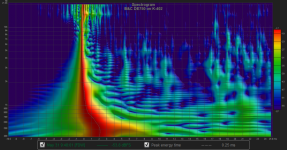
And here is the same plot for a Faital Pro HF20AT on a K-402:
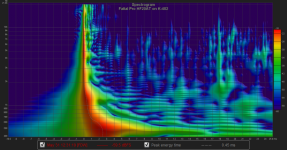
Note that the Faital driver settles down almost within 1 ms and has minimal pre-ringing. The B&C driver has considerably more pre-ringing and ring-out after the peak, in fact, it exhibits a pretty good second, third, and fourth slap relative to the Faital driver. Both drivers sell for about the same cost in the US. :Listening tests correspond closely with the evidence from these measurements.
P.S. Sorry I can't make the plots bigger as these images are right up against the image size limit set by the forum admin. I recommend zooming in on the plots to see the nuances of their respective transient responses. The vertical plot divisions are 1ms width.
Here is the same plot for the TAD TD-4002 on a K402 horn:
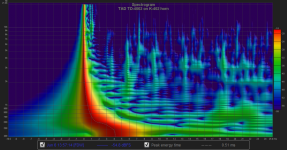
The difference in transient response between the lowly Faital Pro HF20AT and the TAD TD-4002 is actually a bit difficult to hear, and it certainly doesn't knock you down like the B&C DE750 transient response using cymbal-heavy recordings. I personally would recommend the Faital Pros first to anyone, then let them decide if the cost of drivers at 10x the price is worth it. I would assume that this is also the case for the Radian 2" Be diaphragm driver.

The difference in transient response between the lowly Faital Pro HF20AT and the TAD TD-4002 is actually a bit difficult to hear, and it certainly doesn't knock you down like the B&C DE750 transient response using cymbal-heavy recordings. I personally would recommend the Faital Pros first to anyone, then let them decide if the cost of drivers at 10x the price is worth it. I would assume that this is also the case for the Radian 2" Be diaphragm driver.
Last edited:
- Home
- Loudspeakers
- Multi-Way
- Smallest Footprint Horn and Driver that can reach 500 Hz
